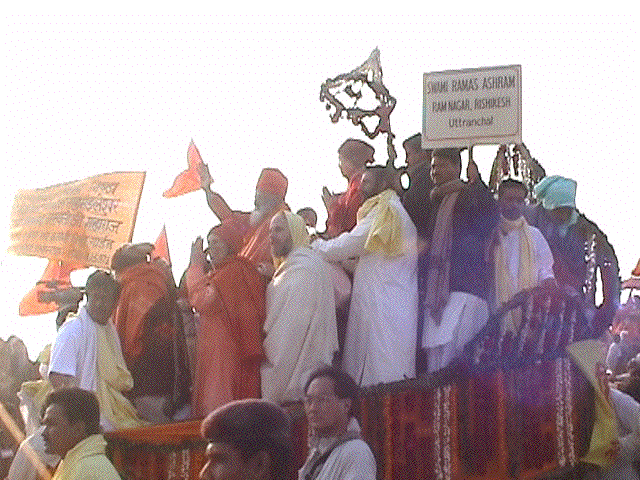

The Maha Mandaleshwara Sri Swami Veda Bharati in procession with devotees from the Swami Rama's Ashram 'Ram Nagar' in Rishikesh.
January 2001, Allahabad. Emerging from the sacred dip on the banks of the Ganges River at the Maha Kumbha Mela, Swami Veda Bharati assumed the full weight of his spiritual role as one of the most respected swamis of Hinduism, and of his own responsibility in continuing the teachings of his gurudeva Swami Rama.
"The experience confirmed and enhanced the authority granted by Gurudev Swami Rama" Swami Veda said after completing the sacred bath at the sangam -- the confluence of the Ganges and Yamuna rivers -- on January 24, the most auspicious day of the month-long Kumbha Mela celebrations at Allahabad.
"Only after taking the dip did I feel in me that I am a Mahamandalesvar," said Swami Veda, who was conferred the position in March, 1999.
"I immediately felt a sense of spiritual authority; that I now own the position. It conveys a sense of responsibility to lead which is greater than before," Swamiji said after partaking in one of the most colorful celebrations in the month-long festivities.
An estimated 20 million people took to the waters on January 24 -- the Mauna Amavasya, a date and time ordained by the pandits as occurring only once in 144 years, and the first in the new millennium.
The streets in the makeshift tent city set up on the dry river bed of the Ganges turned into a mammoth gathering of swamis, sadhus and devotees from all over the world as they prepared for the auspicious bath that day -- the highlight of which was a procession starting before dawn which Swami Veda took part in for the first time.
Gathering before dawn in the chill of the north Indian winter, initiates and devotees in Swamiji's camp joined a five-kilometer long procession which snaked its way for half an hour through the makeshift city, along a temporary pontoon bridge before reaching the sangam.
Watched over by Indian security forces -- on foot or mounted on horses -- and armed with wooden lathis (sticks) the procession wound its way through the surging crowds.
It was a scene which conjures images of processions in centuries of Maha Kumbha Melas -- which occur every 12 years. But instead of caparisoned elephants, the ochre-robed Mahamandalesvars were carried on iron trailers hauled by diesel tractors summoned to duty from wheat fields of Uttar Pradesh.
While Swami Veda had attended previous Kumbha Melas since 1952 -- all of them in Haridwar -- this was the first time he was participating in Allahabad, and the first time since he was conscrated as a Mahamandalesvar in March, 1999.
On a trailer decorated in maroon cloth and festooned with marigolds, jasmine and roses, Swami Veda sat on a silver-plated throne chair. Beside him sat Swami Hari, smiling beatifically, while Pandit Dabral stood by, looking poised and calm. A dozen or so devotees crammed on to the trailer for the five-kilometer long journey, while others walked behind.
In the pre-dawn darkness, the belching diesel fumes from the tractors and the confusion which often accompanies such processions in India, the significance and grandeur of the procession was not immediately palpable.
But as the sun's rays shone over the Ganges, the full magnitude of the crowds became apparent. It was an awesome spectacle.
Families lined some thirty-deep behind wooden barricades all along the procession route. They chanted, they sang, they clapped. Many held out their hands to ask for a blessing or a rose petal from a passing swami. Policemen laid aside their truncheons to throw flowers on to passing trailers of the procession.
Such is the faith in the power of these swamis, that in the past, pilgrims have been known to roll in the sand of a swami's trailer which had passed. Those gathered on this day were were the same pilgrims who had huddled over open fires, barely shielded from the cold of winter in thick blankets while they slept in the open. Entire families, even villages had walked -- some for over a week -- to witness this scene and to bathe.
Throughout the Kumbha Mela celebrations, loudspeakers at the makeshift city had blared announcements asking for lost ones to report to police posts to re-unite with their families. In the week before devotees of Swami Veda arrived at Allahabad, Indian newspapers had carried reports that 5,000 pilgrims had already been reported lost during the Kumbha Mela in which an estimated 70 million people were estimated to have attended.
Forty minutes after it started in darkness, the procession reached its destination and the devotees joined Swami Veda for a quick dip in the Ganges. Battling through crowds of other bathers, Swami Veda removed his ochre robes and stepped into the bone-chilling waters for the morning dip at the sangam.
While other devotees shuddered and shivered even as they felt a sensation of spiritual ecstasy as they emerged from the waters, Swami Veda stepped ashore calmly after his bath. "I am a heart patient and a diabetic. And yet I felt no cold as I emerged from the sangam. Instead I felt a sense of internal spiritual healing and a deep love and energy of consciousness," Swami Veda said.
Swamiji said that after the sacred immersion there was a change in consciousness; a deep compassion for each of the millions who sought a blessings. "Which of these do I really need to bless? my mind asked. I scanned the throngs; selected the ones I felt were connected to me no matter how distant in the crowd. Somehow their eyes would mesh with mine and I would raise a hand in blessing". It was all being ordained by some other force.
This "force" which filled Swami Veda with compassion and guided him in his own spiritual realization in the 2001 Kumbha Mela, is the same unseen power which watched over the millions who thronged Allahabad in mankind's greatest gathering for a single purpose -- the search and experience of the Divine.
Dear Loved Ones,
Namaste and greetings from Allahabad. (Actually this was written two days ago and we are now in Varanasi, but more about that later).
We have been safely tucked away at the banks of the Ganges for almost an entire week and have not so far been able to communicate our e-mails to you. It is difficult to get in and out of the camp, especially during the time of the sacred baths. We seem to be busier every day, especially as we become accustomed to moving about on our own, exploring the vastness of the Kumbha Mela. Just to give you a clearer picture, we are sharing a campsite with Muniji Swami Chidanand from Rishikesh and he has gone into great lengths to make this temporary ashram very comfortable. We have running water, sometimes, even half a bucket of hot water, electricity and great food. There is a lot of dust and fog as you will read from one of the journals written by one of our pilgrims from Singapore.
Since we got here we have been doing Yajnas every morning from 9:00 to 12:00 and chanting the Saumya mantras. All pilgrims have the opportunity to offer grains into the sacred fire. At this camp, Muniji has trained many young priests and has about 48 young "Rishi Kumars" under his care. Their chanting is just divine and the Yajnas are enhanced by their their sweet young voices chanting the mantras precisely in unison. What a wonderful way to culminate the practice of the Saumya mantra.
Later I will send you what I have already written about the rest of our days and the visit of the Dalai Lama and Shankaracharya to our camp and the procession of Mahamandaleshwar Swami Veda Bharati and his Akhara to the holy bath at Sangam on 24th.
The Pilgrims
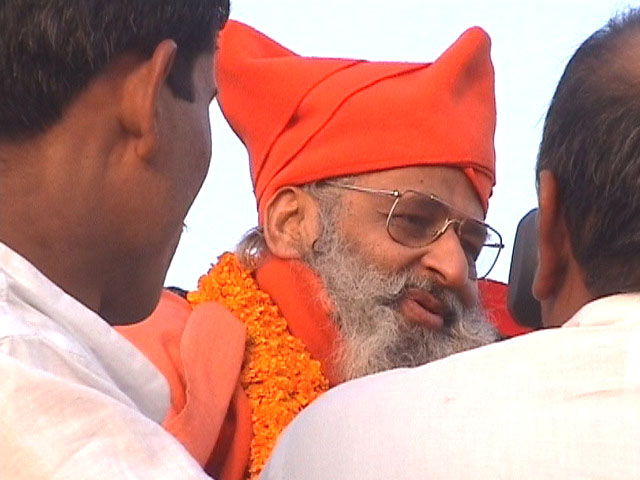
The Maha Mandaleshwara Sri Swami Veda Bharati.
Journal 1: Fire Ritual At Sangam
January 21, 2001
Allahabad, India. Swaying to Vedic hymns chanted over loudspeakers, initiates of and followers of Swami Veda from across the globe gathered for the much-awaited aarti ritual at the Kumbh Mela at Prayag (Allahabad).
After months of detailed planning, and a journey to the sangam -- the sacred confluence of the Ganga and Yamuna rivers -- they joined millions of devotees in what Indian authorities and the world media has billed the largest ever gathering of mankind for a single purpose.
The aarti on Saturday evening was orchestrated by Rishikesh-based Swami Chidanand Saraswati, known as Muniji, with Swami Veda jointly leading the ritual on the verge of the bank of the sangam.
Young trainees for the priesthood, wearing saffron tunics, sang Vedic hymns in unison, to the accompaniment of tabla, flute, and organ -- the music flowing out over loudspeakers. Swami Veda and Muniji waved oil and candle lamps towards the sangam, invoking Mother Ganga to shine the light into our hearts.
For the dozens of barefoot initiates huddled in the chill of the north Indian winter, it was the reward for the long journey to this most auspicious event in the Hindu chronology. For this Maha Kumbh Mela is the most auspicious for its occurrence once in 144 years.
The aarti on Saturday night (January 20) was the second since the group arrived at the campsite late into the night of Thursday (January 18). It was a journey that, for many, began months ago in preparation, through meditation and -- for the organizers -- a logistical endeavour demanding military precision.
Sahara Airlines Fllight S2521 descended from its hour-long journey from New Delhi to the holy city of Varanasi, bringing the first group of devotees, who travelled in a convoy of four buses for about six hours through dusk across the flat, dusty plains of wheat and saffron in the Hindu heartland of Uttar Pradesh.
The destination -- and temporary ashram -- for the next week or so for these devotees is a setting that would defy the imagination of many a Hollywood director. For nowhere else could such a scene be realised, or even conceived.
Millions -- some estimates say up to 70 million people -- will gather at the sangam during the Mela; from naked Nagas (whose only possession is a sword) to saffron-clad sadhus and millions of sannyasis (renunciates)
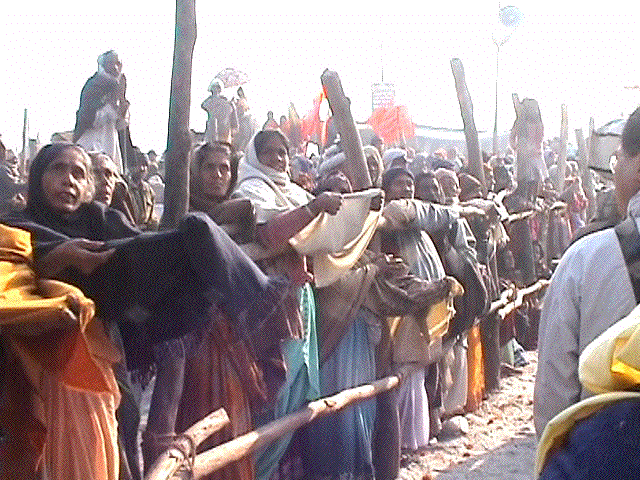
Millions of people at the Kumbha Mela waiting for a 'darshan' - a blessing from a saint.
Journal 2: Take two aspirins (Chant Some Mantras) And Call Me In The Morning
January 22, 2001
Allahabad. Doctors have been summoned from their meditation to perform sewa (service) to devotees and initiates of Swami Veda Bharati who have been taken ill at his temporary ashram at the Kumbh Mela festivities in Allahabad.
Doctors say one of the reasons for the incidence of illness is the thick fog, which has enveloped this makeshift city, trapping the dust and smoke from thousands of fires lit by pilgrims during the north Indian winter, and causing respiratory related illnesses.
"About 30 of 180 devotees at the temporary ashram of Swami Veda have been taken ill -- none seriously," said Dr Mano Murty, who is based in Ottawa, Canada. "The sicknesses are minor and fall into the categories of allergic/respiratory/gastric problems. They are easily controlled with medication."
The temporary ashram has benefited from the services of a number of medical doctors, including Dr. Kalpana Patel from Regina, three from USA and three from Brunei on Borneo Island. Between chanting the Saumya mantra and partaking in fire rituals, they have been taking turns to visit devotees struck with the 'flu bug.
"We have been advocating preventive medicine in a couple of ways," she said. "We recommend intake of at least one liter of water a day, regardless of whether people think they need it or not. We also monitor symptoms to make sure that the infection does not spread to the chest. Finally, we have been advising devotees not to practice the fast -- we had one person who fainted while fasting at the Kumbh Mela."
Despite the austere conditions -- millions gathered in makeshift tents on the banks of the Ganges and Yamuna rivers. Everyone is careful about using bottled water and the food at the temporary ashram is surprisingly tasty and filling.
Dr. Rajeshwari from Brunei said doctors have been mostly prescribing symptomatic relief such as antihistamins, an anti-allergy. "We have not started to prescribe antibiotics unless there are cases of lung infection."
Asked about having to perform medical duties while on a pilgrimage, she said: "Wherever we go, it is our duty, and we are happy to perform it."
But if you think doctors have been spared the flu bug, think again. "We are having the same problems. We are also human."
Journal 3: Dutch TV Records Documentary on Swami Veda At Kumbh Mela
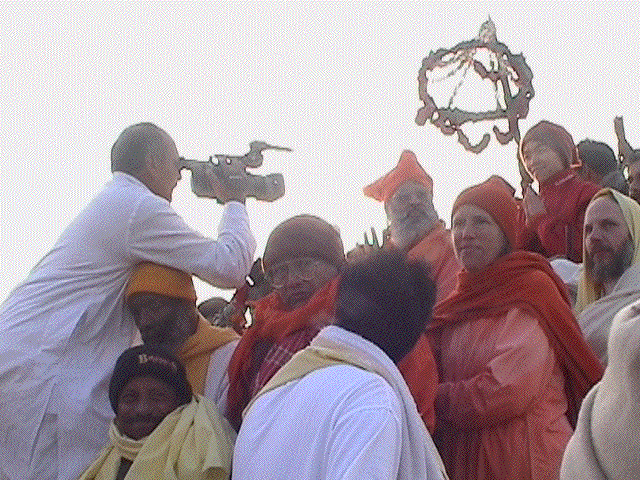
A cameraman from Dutch TV records the procession with Swami Veda Bharati.
January 23, 2001
Allahabad. Swami Veda Bharati, a well-known figure to the Indian community in Holland, will be featured in an extensive four-hour television serial to be aired in April to an estimated audience of half a million viewers.
A television crew on assignment for Om Television channel of Dutch national television has been busy recording valuable footage of Swami Veda at ceremonies during the Kumbh Mela festivities in Allahabad. To be aired over four weeks from April, the program will feature Swami Veda, the Kumbh Mela itself, the yajna fire ritual, and the Dutch participation in the Kumbh Mela.
"Swami Veda is a personality well known to the Hindu community of Holland. They regard him as one of the great writer, poet, philosopher and thinker of our time. He has appeared on Dutch television many times before," said Rabin Baldewsingh, who is directing the program.
Despite being based in the United States, Swami Veda's links with the Hindu community of Holland and its former colonies run deep. Between 1956 and 1962, Swami Veda was based in South America, where he did extensive missionary work, including the establishment of an ashram in Guyana in the late 1950's, among the Hindu community there.
His work involved travel and interaction with the Hindu community in Dutch Guyana (renamed Surinam after independence in 1975), British Guyana and Trinidad. In these areas, "he brought education to remote village areas, trained hundreds of cultural leaders and re-awakened the consciousness of Indian traditions," according to his official curriculum vitae.
Despite his schedule during this period in South America, Swami Veda found time to participate and contribute to the literary scene. He wrote songs and even penned a play -- on immigration of the Indian community to Surinam, said Baldewsingh.
The presence of the Hindu community marks an interesting period in the confluence of histories of India and Dutch colonialism in the 19th century, in which Swami Veda was later to play a role as a chronicler of the oral traditions of this period.
With the abolishment of slavery in the 19th century, the European colonial leaders sought to find workers for its plantations across the globe. Indentured labor from India became a source of inexpensive labour to toil the fields as far flung as Fiji and South America.
Farm workers from Bihar and Uttar Pradesh were brought to South America by the colonial masters in both British and Dutch Guyana, said Baldewsingh, a Dutch national of Indian origin.
Apart from his mission work, Swami Veda also became interested in the folklore of these indentured labourers and started to conduct pioneering research of these songs as an oral history of their migration across continents.
Armed with his research on this folklore, Swami Veda later applied for a doctoral dissertation with the University of Utrecht in central Holland. Despite not speaking Dutch, he was accepted by the university -- one of the oldest and best-known universities in Europe and went on to complete the dissertation.
That study was published in 1968 by E.J. Brill of Leiden, Holland, as Ritual Songs and Folksongs of the Hindus of Surinam.
Achievements such as these have endeared him to the Hindu community in Holland, which now numbers about 200,000 of the total population of 16 million. The community speaks a unique patois known as Savnami Hindi which combines Dutch words with Hindi.
"I have had a very long connection with the Hindu community of Surinam -- with some families it stretches for three generations. They have a very special love for me," said Swami Veda.
"I enjoy all communities in all parts of the world. But the people of Surinam originally came from a very, very simple background. I enjoyed and learnt about that simplicity from them. From the last to the present generation the level of education has risen dramatically -- farmers' children have now become scientists and professors and still they have not changed their commitment to their spiritual traditions," said Swami Veda.
Dear friends,
The Maha Kumbha Mela 2001 - the Festival of the 'nectar of immortality' - - bringing together 70 million people in one month, is coming to its end. Many of us have returned from the 'Kumbha Nagar' (= Kumbha City, a 1,200 hectare township), formed along the sandy floodplains of the river Ganges and the Jamuna. Many of us have gone through an experience as a 'pilgrim' that will have impact on us; it will transform us in someway or another....the great monks and saints said so. Being together with some 30 million pilgrims from all over India and all over the world on the 'Maun Awashya' on the 24th of January 2001 has created an awareness within us of togetherness, solidarity, collectivism, and the common spiritual grounds. We have also become aware of the weaknesses of words required to describe the experiences accumulated during the Maha Kumbha Mela, held once every 144 years ('normal' Kumbha Melas are held once every 12 years). That is the reason why I am sending you a few photos to give you a better impression of the activities and the atmosphere:
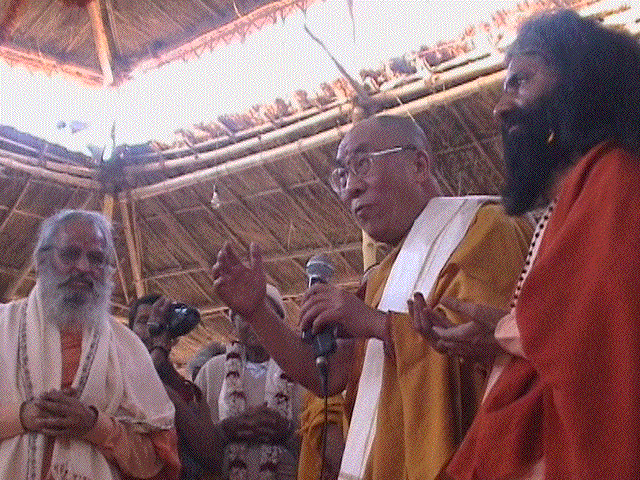
Meeting of the Saints: Swami Veda Bharati with H.H. the Dalai Lama and Swami Chidananda Saraswati.
The ENCOUNTER Photo above shows the 'encounter' between Swami Veda Bharati (left), His Holiness the Dalai Lama, who joined our international group on the 25th of January 2001, and Swami Chidananda Saraswati (Muniji). During this gathering the Dalai Lama and the Great Shankaracharya (the highest Hindu Religious Leaders in India) announced the 'unity' of Hinduism and Buddhism. This recognition came after some centuries. They both emphasized the importance of tolerance and respect of religions, including those without a religion. Atem has made a video of this historical 'encounter'!
The BRIDGE Photo below gives an impression of how the millions of pilgrims were crossing the Ganges rivers, using one of the thirteen pontoon bridges made by the Indian Army. A life experience to walk in that crowd: families carrying their belongings from far away villages, children, elderly ones....
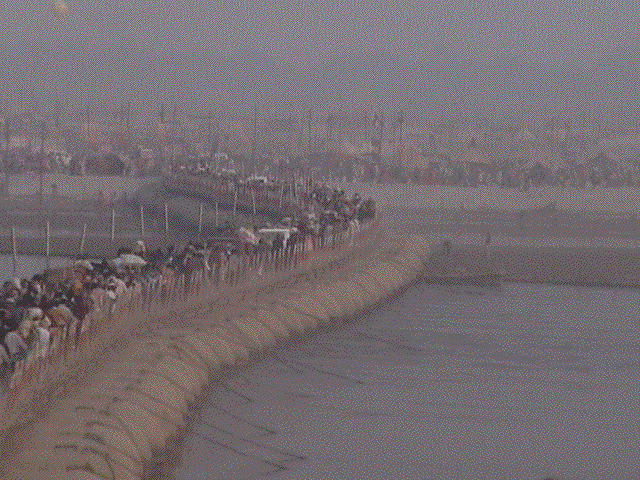
The SAUMYA Photo below gives an impression of the international group consisted of 24 different nationalities and cultures: Asia, USA, Europe, Africa ! They were guided by Swami Veda Bharati. The photo shows the fire offerings and recitations of the 'Saumya' mantra aiming at awakening the 'feminine' force within us. This 'feminine beauty' is needed in us to make world peace and to become aware of the link between all beings in the Universe.
Many spiritual seekers who have listened to the songs of the mystics ask a question: "Is it not said that all the sanctity is within one's person: that it is not by much walking, or taking dips in sacred pools that one will be liberated, but by internal surrender, purification, diving deep within ? "If taking a dip in a river would grant me liberation, the fish would have been liberated long ago." says Kabir, a philosopher. Why, then, all this talk of pilgrimage ? Subject for further gatherings....
Yes, the 'residents' of the Kumbha City have been suffering from dust, the cold weather, smoke and smog. Yes, indeed the water quality of the Ganges river is bad. About 6,000 sweepers have kept the Kumbha City clean, pushing away 200 tonnes of solid waste by trucks every day. No flies, a few mosquitoes. Millions of liters of milk and millions tons of food had to be brought to the area. Civic and Urban management has been demonstrated: Indian civil servants have worked around the clock to ensure ones safety and security. Some 36 fire departments were active to kill fire in the city; a media centre and a hospital were set up too. Water and sanitation were made available almost in every road junction. Thirteen pontoon bridges were built by the Indian Army to connect the city of Allahabad with the Kumbha Nagar. A loudspeaker system (a used in prisons) ensured the provision of information and guidance everywhere; 10,000 families who lost each other in the events could find each other at the communication centre of Kumbha City. No fights, no riots, no deaths! All residents had the same purpose and no conflicting interests.
Once there in Kumbha Nagar, and with each other, one does not focus on minor physical insufficiencies or short comings or on the 'nakedness' of respectable saints and monks (male or female), but on the sense of being ONE. Whether Hindu, Buddhist, Sikh, Jain, Christian or Muslim. All realize that we desire to merge into ONE.
Hope to be there again in year 2145 !
Regards and love,
Atem Ramsundersingh
(Holland)
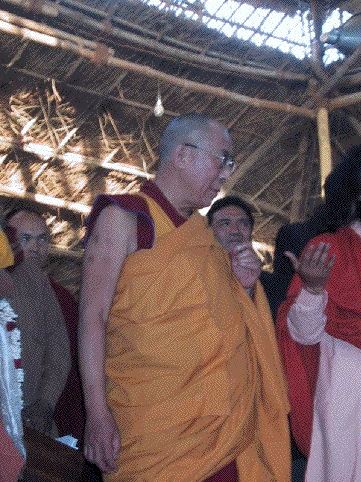
Dalai Lama: My Dream For Tibet's Freedom,
Interview with Professor Thubten Jigme Norbu, elder brother of H.H. the Dalai Lama
Tibet: Give us Liberty, by B. John Zavrel
Swami Veda Bharati in the procession with devotees from Swami Rama's Ashram Ram Nagar.
After several warmer days in the sandy flood plain of Ma Ganga in Allahabad, a raw, cold, dusty, dry wind gusted heavily all night over the Kumbha Mela. Excitement and anticipation rose within each of us as we huddled sleepless in our sleeping bags in the traditional but comfortable camp provided by Swami Chidananda Saraswati (Muniji). At 3 AM up and down the rows of temporary brick cottages the sound of watch alarms beeped although most of us were up already anyway, tying our dhotis, arranging our yellow initiates' scarves and trying to figure out what few things to stuff in our pockets for the sacred bath in Mother Ganges on the day of mauni amavasya. It is the full moon of silence and the most auspicious day during the Maha Kumbh Mela. While this event takes place once in 12 years, the 2001 Maha Kumbh Mela was significant in that its astrological occurrence is taking place for the first time in 144 years, and the first in the new millennium. A small party of twenty or so men had been allowed to process to the sacred confluence of the Ganga and Yamuna rivers with Swami Veda's elephant (consisting of a tractor and trailer with a flower bedecked throne) in the procession of the Niranjani Akhara, the monastic organization within which he is a Mahamandaleshvara.
Clad in white kurta, dhoti and scarf, some devotees had to be buffered by thermal underwear in the 40 degrees F pre-dawn chill, while some chose to participate barefoot. The contingent set off 4:10 AM from Parmarth camp for the 10-minute walk to Swamiji's own camp. The Shankaracharya Marg, the 100-foot-wide main street in this part of the makeshift tent city of 20 million, is packed side-to-side with pilgrims even in this early hour. Vehicular traffic had been banned altogether for the past two days. Reaching Swami Veda's camp, we formed up into a procession, Swami Veda at the head, followed by our sannyasis, Ma Tapasya, Ma Seva, Swami Hariharananda, Swami Asanga, and then by those of us accompanying him, close students from many countries.
I slip off my sandals and the soles of my feet sink into the fine, white, cold sand of the sangam &endash; the sacred confluence of the Ganga and Yamuna rivers. Let these feet be as open as possible to the energies of this place and time. We are instructed to walk in silence and to keep our minds focused on japa of the Saumya mantra. This is in stark contrast to 24-hour din of the loudspeakers and the surging crowds as millions move, laughing and shouting, towards the sangam.
The Akhara camp is a short walk across Kali Marg and the tractors with all of the Mahamandaleshvaras' decorated thrones are arrayed around the outside. As we move inside the camp, swamis acting as marshals and armed with silver-plated sticks brusquely direct traffic and our line is at first sent the wrong direction. But we quickly found ourselves in a desperate crush that makes it easy to understand how one could suffocate standing up in this place. Soon, however, the problem is righted and we found ourselves in line besides others groups of disciples, the Mahamandaleshvaras all having taken their seats on the stage for some brief ceremonial organization. I recognize M.M. Santoshi Ma, one of the lady Mahamandaleshvaras who attended the United Nations Religious Summit last summer. She has kindly arranged to host Ma Tapasya and Ma Seva in her procession for the bathing as male and female swamis bathe in different areas.
We left Swami Veda's camp at the about 4:30 and it took some time for the processions to organize themselves. There procession of Mahamandalesvaras taking the sacred dip is traditionally led by the Naga Babas who are the first to take the sacred bath. By 6 AM the tractors are starting up and we are on our way out again into the crowd. The sangam is a relatively short distance from the camp but it took another hour to arrive at the sacred spot at our appointed time of 7 AM. Many climbed aboard the trailer with Swamiji, especially Swami Hariharananda, and the rest of us followed along behind, having greater or lesser success keeping to our japa. Excitement and glee ran high all around us, although by comparison, we are an almost sombre group. Slowly we made our way across the pontoon bridge a few feet at a time. Arriving on the other side I felt the energy rising into my heart and tingle over the crown of my head. Looking up, I saw the red ball of the sun coming over the horizon. Within, I withdrew to the place of the inner teacher and remembered Swami Rama with deep gratitude for having brought us here right at dawn. "Pratah smarami hrdi samsphurad atmatattvam"&emdash;"at dawn I remember that true self flashing in the heart." Quietly tears flowed with the thought, "I have been here before," returning to touch, however subtly, the waters of some previous birth.
We top the rise above the Sangam precisely at 7. Many things in India are difficult to do on time; Kumbha Mela is not one of these. Everything ran right on time, because any deviation from the negotiated schedule could have touched off a riot - and hundreds have died in previous Kumbh Mela incidents. But our mela was peaceful. Just as we dismounted our carriage and prepared our things, the shout of the Naga Babas went up and they sprinted for the water. Now all the wraps came off (though no one but the Naga Babas bathe entirely naked). Hundreds of us were all grins and gooseflesh. The wraps of sober, silent patience come off people's comportment in child-like delight. The wraps came off the heart and our heats beat as one, together as big as the Triveni Sangam itself. Some go all the way in; wade far into the Sangam laughing and splashing, some jumping and dunking, praying and shouting. Some stood in quiet prayer, facing first the current of grace upstream, then towards the sun downstream, poured a bit of water from their hands and gently ladled the grace of Lady Ganga over their heads, over and over, taking the dip for those they know who could not be here. Prayers filled the air all round and thousands of grinning giggling faces, many of them with lower jaws chattering in the cold beauty. Swami Veda somehow evaded his companions for a moment and managed a private bath, alone with the millions of us in a prayerful moment of great sanctity.
Soon the marshalls' whistles were blowing and they came with their sticks to shoo us out of the water in preparation for the next procession and the next gleeful charge of Naga Babas. Grateful (but cold) we gathered our things and mounted the bank to rejoin our carriage and make the painfully slow way back to the Akhara camp &endash; a procession which took over an hour, three times as long, because of the crowd. As we waited on the pontoon bridge for the parade to inch along, we began to pull apart the garlands on the carriage to throw to the crowds of people pressed against the barricades. Swamiji and the rest of us felt obvious delighted offering the roses and marigolds and the small white flowers in the garlands to the deeply appreciative pilgrims. As we passed crowds of destitute people, many of whom had come hundreds of miles to be here with no food for days for the sake of faith, I watched Swami Veda blessing them, silent, his eyes deep with compassion, his right hand raised in the abhaya-mudra, the gesture of compassion, conveying no need to fear.
Finally, at long last, we reached the Akhara camp at 9 AM. Deeply satisfied we headed back to Parmarth Niketan, down the Shankaracharya Marg's crowds, surging since 3:17 PM the preceding afternoon when the Mauni Amavasya began. Back in camp, Muniji later led those who were unable to accompany the procession to a location on the but away from the main area where the Akhara continued to process and bathe. As my companion was too ill to go in the early morning I decided to accompany him now. Unlike the formal procession, the way is easier as Muniji had police escorting us all the way, holding back the crowd at the crushing intersections and parading us all under the yellow Parmarth banners. When we reached the bathing spot, the Rishi Kumars from the Parmarth School, orphaned boys 9 to 14 years old in a traditional gurukula learning to be priests, formed a cordon around the group so that there was room to change and bathe. The energy was the same in the chilly bright sunshine. Some dunked, some prayed, some jumped and splashed, and again, all around, the thousands of grinning faces, their lower jaws chattering and not noticing it.
After most of the pilgrims had bathed, we joined hands in the cordon to relieve the Rishi Kumars who charged into the river for their moment of playful worship, cheered on by Muniji on the shore clapping and directing people. After a few minutes, the boys formed a circle in the water and begin to chant formal prayers, with their usual gleeful energy. When they finished we all slowly made our way back, deeply refreshed, deeply grateful and washed to our core of silent, shimmering light.
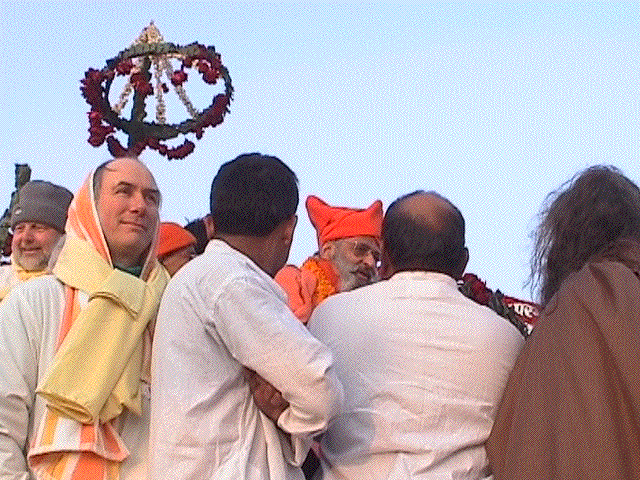
Swami Veda Bharati on his way back from Sangham, where he took a holy dip. Wolfgang Bischoff from Hamburg (far left) and Ingo Beardi from Berlin are among his company.
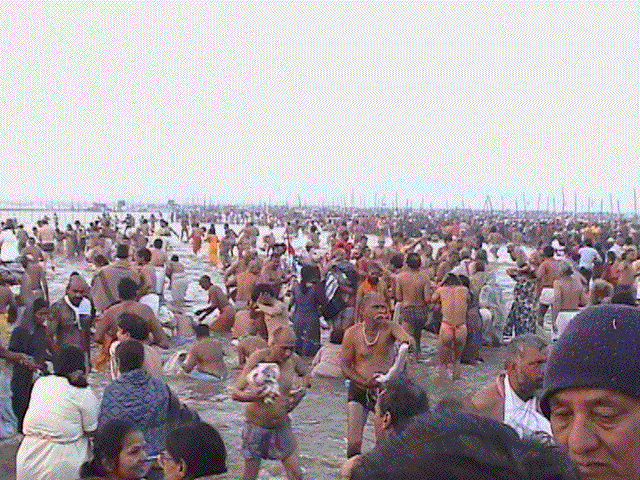
The MAUNA Photo above shows the holy bathing of the great saints on 24th of January 2001 at approx. 06.00 hrs at the 'Sangam' i.e. the spot where the three rivers i.e. the Ganges, the Jamuna and the underground river Saraswati merge into One Flow to continue its journey. On that 24th of January we all walked a few kilometers to the 'Sangam' area. It was a beautiful day, with temperature at around 5-8 degrees C and lots of wind. After the dip one does not feel being in 'heaven', but cold ! Now it is understood how one 'washes' its sins off and starts with a 'clean' life.
Our last few days at Kumbha Mela Jan 24 to 26th
After Swamiji and most of the men returned from their morning dip with Swamiji's procession from the Niranjani Akhara, we sat for Yajna with renewed energy within the air of excitement. Some of the men had returned dancing with happiness, full of episodes that had taken place during the morning. The lady pilgrims began to look forward to their dip.
Muniji and his staff were so kind and hospitable and extended invitations and even transportation to all their wonderful programs. Again he showed immense compassion in arranging the dip for the ladies and gathered the Rishi Kumars in the afternoon to lead us towards the part of the Sangam where Artee is usually held. Muniji, the singers, young priests and many pilgrims from Parmarth camp started off with the cry of "Gopal Krishna, Radhe Krishna". As the little ochre-robed ones led us with their banners held high, the crowds made way for us to pass. On this Mauni Amavasya there was hardly any room on the streets to walk and when we reached the edge of the banks of the Holy Ganges, we noted that we were certainly not the only ones looking forward to our holy dip in the Ganges. Muniji stood on the banks like a loving father as we all prayerfully entered the shallow water. Even in the afternoon, the coldness of the water left a tingling, refreshing feeling to the body and a curious rejuvenation of the mind. Many of us formed a circle chanting the Saumya mantra and after the initial prayers and offering began spontaneously splashing and enjoying the moment of being with each other in the water. What a wonderful feeling it was!!
On that Wednesday evening Swami Veda and the pilgrims proudly honoured Muniji by showering him with rose petals and presented him with gifts of love. Ann Glazier from England, Wolfgang from Germany, Christina from Italy, Idriss from Burkina Faso, Kailash from USA, Atem from Holland and others gave thanks on behalf of Swamiji and the pilgrims. Many spoke of the wonderful atmosphere in Parmarth's camp and of the compassion showed. . Muniji responded with much love and grace and gave packets of information relating to Parmarth. As you know, Muniji's ashram is in Rishikesh and he warmly extended invitation to Swamiji and all pilgrims to visit his home ashram there.
The next day passed by in a whirl of activity and excitement. We were expecting the Shankaracharya of Kashi and the Dalai Lama to visit our camp! Shri and I sat as Yajmanas and the Yajna lasted for three hours. Initiates took turns in giving offerings into the sacred fire to the chant of our Saumya Mantra. After lunch the Yajna resumed and our Special Guests, the Shankarachrya and Dalai Lama joined us about 4:30 for a few special offerings and to see the exhibition of wonderful photographs of Mansarovar where Muniji is building schools and facilities for the poor. We were quite excited to be in such close proximity to the Dalai Lama. He was so happy and spontaneously made offerings into the fire as we chanted the Saumya and the Tara mantras. He is truly a wonderful example of purity and love and gave a talk in English.
This is mostly the text of the Dalai Lama's talk given on January 25, 2001:
The Dalai Lama spontaneously addressed the devotees:
"Just I want to express my deep feeling. It is the second time I visited this place; I think in 1966 I came to Kumbha Mela first time. This is the second time.
I think many of my friends may know I always try to promote human values and religious harmony. So, now, as far as promotion of human values is concerned, although we have no right and no use to impose religious faith to non-believer… as non believer should remain non-believer &endash; that is their own right. But at the same time, for the promotion of human values, various traditions have important role. So therefore, not thinking how to convert or make people believer &endash; not that way! How we can make contribution to the promotion of human values including non-believer. For that, a closer understanding, genuine unity among the children of different traditions is extremely important.
So this is not just smile with one another and express few nice words to one another. That is not sufficient. We must participate to the other religious traditions for the experience.
We must, through participation gain deeper understanding through that way automatically develop genuine respect, genuine admiration. So that is why, whenever I get the opportunity to make a pilgrimage to some holy places of Christian, some Muslim or various religious tradition…..
Now, as far as Hinduism is concerned, I always considered this is like twin brother/sister, same sort of practice, same sort of root there. Very special - although in the past more than 2,000 years a lot of defeat with Buddhist masters and Hindu masters &endash; doesn't matter.
So therefore, I have always believed that between Buddhism and Hinduism we should develop a closer understanding. Sometimes I feel that my relationship with Christian brothers is more closer than Hindus. So therefore, I am very, very eager to come to this place and meet…… (applause) Hindu masters, brothers and sisters. So today, one of my dreams is realized.
Now my humble request or appeal is wherever I go to participate in religious or even political function, - everybody's mouth word of peace is always there but now peace must be within oneself and inner peace can transform into action &endash; in that way we can promote genuine peace. Peace in the family level, at the community level, at the national level and in our individual self.
If we remain undisciplined mind, no commitment, no compassion, no tolerance, under that circumstance prayer for world peace is unrealistic.
Therefore if we are really concerned about world peace, first must improve ourselves. Through that way we can really transform the world and world can be a more peaceful, more compassionate, more friendly and perhaps more spiritual".
There were so many cameras and reporters but for the most part, the Dalai Lama's visit was very protected from the general crowds at the Kumbha Mela. He then went on to see the exhibition of wonderful photographs of Muniji's project at Mt. Kailash.
Everyone then piled into Army trucks and were moved towards the Sangam where we were to witness Aarti on the Ganges. The Shankaracharya and Dalai Lama, Swami Veda and Muniji reached there first and went straight to the spot on the banks of the rivers. Our transportation was not allowed to cross the pontoon across the river so we were dropped off about 10 minutes away, and we mostly ran in our eagerness to watch this historic moment where the Shankaracharya and Dalai Lama would wave the lights of the Artee honoring the sacred spot at the confluence of the holy rivers. The Dalai Lama spoke in his language and we managed to get some wonderful pictures. He was whisked away shortly afterwards and our group walked back amongst the crowds toward our camp. On the way, we stopped at Swamiji's Niranjani Akhara and saw many Swamis, Sadhus and Naga Babas in different activities, some having dinner and some chanting at the main shrine.
January 26, 2001
On the last full day of our pilgrimage to Kumbha, Swamiji and Pt. Hari Shankar Dabral led us in the final offerings of the Saumya Mantra. Swamiji conducted initiations of the 'vanprastha nastik diksha'. Among those who received this initiation were Margo Balog, Ann Glazier, Wolfgang Bischoff, Ingo Beardi, Pandit Ananta, Yumi Ito and Mr. and Mrs. Jachak. Muniji came to the Yajnashala congratulate the new initiates. We again thanked him for his love and kindness and Swamiji made love offerings to the young priests, to Pandit Dabral and to Pandit Prakash. All remained serene yet with hearts bursting with joy and harmony as we completed the purnahutis or final offerings into the sacred fire. Afterward, when the ashes from our week long Yajna cooled, Dr. Patel placed them into little bags to be handed out to the pilgrims to take home with them.
Later that afternoon, some packed and others went out into city of the Maha Kumbha Mela, taking in the smells, sights, sounds and feel of this holy place. Some even went to Ganga Artee with Muniji and the Rishi Kumars. Soon we will be based at the hotel in Varanasi and it would all be a wonderful scene etched in our memories. After dinner, everyone did their final packing. Some of us went to say goodbye to Muniji before he entered into silence. The buses arrived were loaded the luggage into the respective buses. We said goodbye to that wonderful place of so many divine memories in the wee hours of the morning and travelled toward Varanasi.
January 27, 2001
As our four buses drove away from our temporary home at Parmarth for the period of 9 days, we all had mixed feelings, mostly sad to leave. Everyone tried to get some sleep as the trip started to Varanasi. After we had travelled for a few hours however, all traffic came to a standstill. There had apparently been an accident ahead since midnight before and so the roads were totally blocked. No one knew how long we would have to wait. We were literally in the middle of nowhere; although there were lots of cars, trucks and buses. There was a teashop nearby but no bathroom facilities. Before long everyone started alighting from the buses moving around and chatting. Needless to say, many temporary bathrooms sprung up out trees bushes and brick structures! Josh did his asanas and meditated right in the middle of this scene. What an inspiration he was! We waited here for almost four hours before traffic began to move!
Our first stop was for tea and to see the place where Mother Sita of the Ramayan had disappeared into the earth. This is a wonderfully peaceful temple, cool and serene. Swamiji explained about the story of the Ramayan and then we set off again to have lunch with a family in Vindyachal. It was originally planned to be breakfast but we managed to be there after lunch. Nevertheless it was very enjoyable and varied. We walked to a temple dedicated to the Divine Mother &endash; Sri Vindyavasini Devi and we took turns filing into a small space and finally to offer our prayers there. Swamiji explained that this was the same deity that manifested herself to be exchanged thus saving Lord Krishna from the hands of his cruel uncle.
We arrived at the Taj Hotel about 7:30 p.m. and were very happy for hot showers, clean sheets and much needed rest.
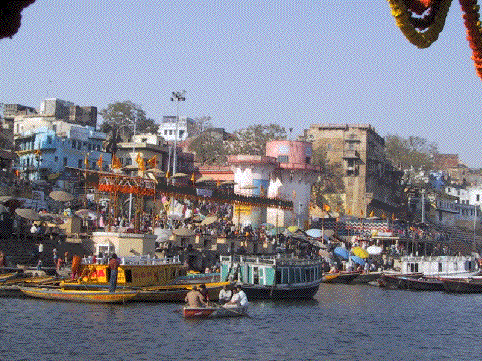
Another view of the ancient holy city of Varanasi.
January 27, 2001
Banaras/Varanasi. Our journey along the Ganges on a beautifully decorated boat was just divine. We arrived at the ghats - long flights of stone steps some as much as 200 leading up to the holy places - about 10 a.m. and took some time to board the boat one at a time. The boat was decorated with flowers and there was a raised area where Swamiji and Swami Hari sat. Swamiji used the portable P.A. system to welcome everyone and to let us know that Mr. Hari Prasad Agarwal was responsible for hosting us in this royal way. Muniji (Swami Chidanand Saraswatiji) had called ahead and asked Mr. Agarwal to help with our plans to visit Varanasi after our nine-day stay at Allahabad for the Kumbh Mela. Not only did he help but arranged everything with such finesse that we were very impressed. Mr. Agarwal and his family arrived shortly after we had boarded in a separate boat which we found out later was the one in which our scrumptious lunch was prepared and served.
As we cruised along enjoying the beautiful atmosphere and in awe of the scene in front of our eyes, Swamiji explained about the ghats and a bit about the history. Hindus call this city Kashi - the Luminous City of Light. There are temples, ashrams and holy places stretched along the river. Pilgrims come to bathe at these ghats from all over India and the world.
This is what Diana Eck says in her book, 'City of Light' of this city which was previously known as Banaras:
For over 2,500 years this city.... has attracted pilgrims and seekers from all over India. Sages such as Buddha, Mahavira and Shankara have come here to teach. Young men have come to study the Vedas with the city's great pandits. Householders come on pilgrimmages, some to bring the ashes of a deceased parent to commute to the River Ganges. Sannyasins come to gather in the monasteries (mathas) and ashrams of Kashi, especially during the rainy season when they were unable to continue their lives as homeless wayfarers. Widows too have come to Banaras, out of piety or out of misery, to take refuge in its temples and to live on the alms of the faithful. And the very old or very ill have come to Kashi to live out their final days until they die."
Indeed, we found out that the waters of the Ganges are called the 'nectar of immortality' and that those who die in Kashi are assured of liberation.
Manikarnika Ghat is the famed burning ghat that we saw from the boat. At any one time, there may be half a dozen cremation pyres burning. It is supervised by the Doms, an untouchable caste. Swamiji showed us the home of one of the Doms and it was a big home. Manikarnika ghat is originally a desirable area for bathing. There is a scared tank called the Manikarnika Kund and is north of the Manikarnika cremation ground.
As the boat moved along the river, Swamiji with Mr. Agarwal's help pointed out the most important ghats and then we stopped to climb 70 steps towards a small temple which has a Shiva Lingam. It was told that the Swami who lived there died in the 19th century at the age of 200. During the time he lived in Varanasi he he took the Shiva Lingam, which weighed 500 kilograms, more down to the Ganges every day for bathing, down those 70 steps and then brought it back up. The Shiva Lingam originally came from the Ganges. This temple was very serene and we engaged in prayers here.
After this, we had a wonderful tasty lunch. I forgot to mention that a chilled fluffed cream &endash; a delicacy of Varanasi &endash; was served in little clay pots. Everyone enjoyed it so much. It was made of boiled milk left out in the dew and then the next morning it was churned until it became of fluffy, marshmallow like consistency. It was very light.
We had a rest even on the boat and then got ready to see and participate in the Ganga aarti which Muniji had arranged for us. The area was so beautifully decorated with flowers and fabrics and Swamiji was welcomed honorably and warmly. Some of us went with Swamiji to the ghat while most of the pilgrims stayed on the boat to view the aarti from the water. There were thousands of people there. The music and organization was divine. After we had done a puja on the ghat, Swamiji was taken to a special seat of honor and he was given the opportunity to speak. His talk was in both English and in Hindi and we were all enraptured and filled with the harmony of it all. He wished much success to all those who carried out the wonderful traditions and gave so much happiness to people.
The aarti began with honoring the Ganges with incense, peacock feathers, and finally the lights. When we glanced along the waters, there were thousands of tiny lights floating along. All of those who went on to the ghat with Swamiji had a chance to wave the lights of the aarti. It was a wonderful, sublime and moving experience.
We all went back to the hotel fulfilled and happy and had dinner together before retiring for the night. Swamiji had a press conference the next day and Kwok Kin, Shri, Kalpana and Vasudevan were all involved in helping with that. Kwok Kin from Singapore not only wrote some of the journal but organized the order of the press conference with much efficiency. The hotel cooperated and made everything a big success. Swamiji was pleased with the outcome.
The next day we would visit Sarnath as guests of the Maha Bodhi Society led by Sumedha Thero. There we would have a wonderful lunch and see where the Buddha preached his first sermon.
More about this later.
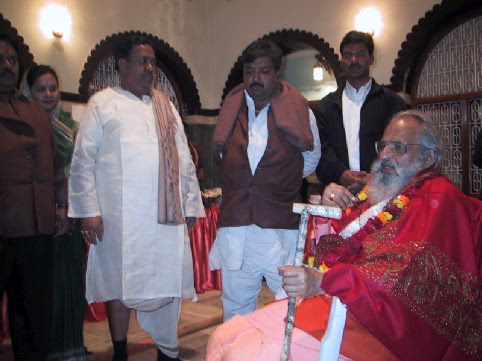
Mr. Agarwal presents the traditional shawl to Swami Veda in Banaras.
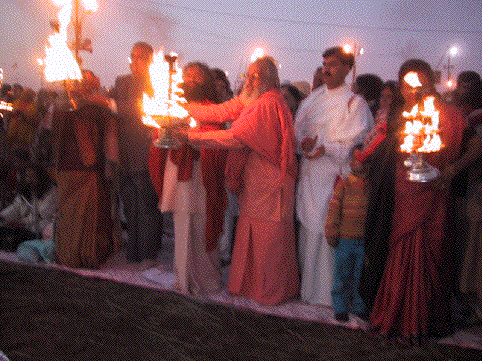
Swami Veda Bharati and Pandit Dabral at the arti ceremony.
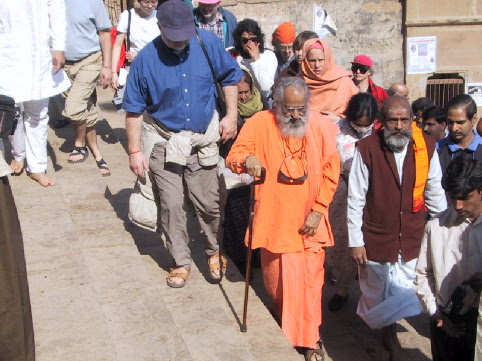
Swami Veda Bharati walking down to the ghat.
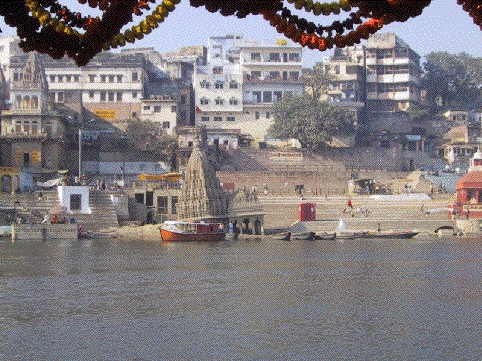
Another view of the ghats at Banaras.
With love
Priya
It is from the personal interior experiences of a certain light of consciousness in awakened great souls that the various religions of the world begin. This experience is indefinable and indescribable. The knowledge thus obtained from such a realization is imparted by these pure souls to their disciples. The disciples, who have not yet reached the highest rung of the ladder, in the absence of the personal experience, fail to fathom the real meaning of that knowledge and fall into the trap of disputations. One royal path becomes divided into many byways (or in Hindi, panths). The teachers of those divisive byways resort to arguments, exterior forms, rituals and ceremonies. This confusion continues until some other great soul reaches the pinnacle of enlightenment (Sambodhi) and re-awakens the personal realization.
To merge the religious disputations into a unitary truth, and to test and personally verify whether such forces as soul and God truly exist or not, the way these goals is that of experimenting with and observing the process of consciousness in the interior mental apparatus (antah karana). This way of diving deep into one's own consciousness is termed meditation (dhyana yoga). The highest rung of this ladder is called self-realization. In the experience that prevails at this level, there is no further scope for divergences of religions. This is how one may rise above religious prejudices through the common spiritual experience. This experience will not be obtained through argumentation, but through internal silence alone.
The entire culture of India, its arts and music, sciences from Vastu to Ayurveda, it's festivals and sacraments, all these originated from experiences of the states of samadhi of the rishis and yogis. Therefore, these as well as the Vedas, Upanishads and other philosophical texts cannot be comprehended without yogic vision. Furthermore, they all lose their meaning without such a vision. The learned people, thinkers and leaders who are concerned about the future of Indian culture definitely need to work for expanding this spiritual vision.
The question may be raised &endash; are there not divergences in the path of meditation just like the ones among the various religious and sects? Is there any ground for coordination among these divergences of the meditative traditions? If there is, where? Nowadays, so many different systems of yoga and meditation are being promoted. Which is the accurate one?
The reality is that in the traditions of Himalayan yogis, all of these are included. It may be said that they are part and parcel of that complete tradition. Whoever is trained and initiated in the Himalayan Tradition has gained an entry in all the methods of meditation. These methods are not mutually contradictory but are complementary. Each has a particular place in the entire framework. The systems of all these merge together, plus more, constitute the Himalayan Tradition. The system of this tradition is entirely scientific. The great yogi Swami Rama of the Himalayas proved this fact.
In the decade of the 1970's, Swami Rama offered himself to psycho-physiological research laboratories in the United States, and demonstrated to the highest specialists in this science, as to how the spiritual consciousness and mind's channels control and direct the body. For example, he produced different temperatures in two different muscles of the hand simultaneously. He also demonstrated through brain wave recordings that even in the deepest sleep he could remain conscious at the same time. The reports of these scientific events are not to be found in religious or spiritual magazines but such scientific publications as Encyclopaedia Britannica &endash; science supplement 1973. This produced a spiritual revolution in the psycho-physiological research throughout the world. We now have bibliographies of nearly 2,500 articles in scientific journals reporting the results of other experiments demonstrating the efficacy of yoga and meditative practices in commanding both voluntary and involuntary systems of the body.
The scientific method of meditation taught in Swami Rama's Himalayan Tradition is the easiest, most effective, and can be practiced by followers of all religions. This method is a common denominator among all meditative traditions such as those of Thera-vada, of the Southern Buddhist school, Tibetan Mahayana, Chinese Ch'an, Korean Son, the Japanese Zen schools like Soto, Rin-zai, Shin-gon, the Sufi Dzikr, the Christian Prayer of the Heart and many others. The method of integral breath awareness (pranapana-smrity-upasthana) is taught in the yoga sutras of Patanjali and the Master-disciple tradition of the Himalayan yogis.
By this method we merge the experience of the spiritual seekers of all religions; prevent diseases such as hypertension, migraines, psycho-somatic ulcers; we counter the stresses of daily life; we eliminate distances between sciences and religion; above all we evoke almost instantly a state of peacefulness in agitated minds. Finally, we lead the practitioner into the path of self-realization.
Those attending this press conference will be led into a brief experience of this method of meditation.
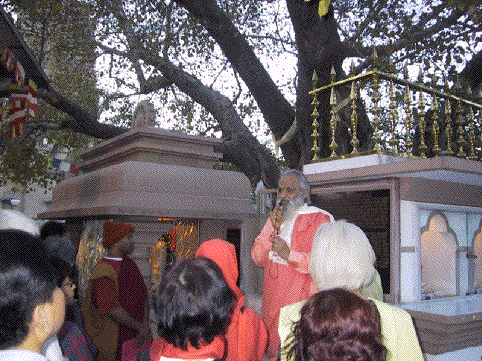
Before meditation, Swami Veda stood under the Bodhi Tree talking to the pilgrims.
Our group was very fortunate to visit with the Maha Bodhi Society in Sarnath on January 29, the day after we had seen the holy ghats of Banares and participated in a wonderful Ganga Artee.
It was at the World Peace Summit in New York in August 2000 that Swamiji indicated to the venerable Sri Badhanta Sumedha Thero that his group of pilgrims to the Maha Kumbha Mela would be very interested to visit the place where the Buddha preached his first sermon. We were well received in Sarnath and enjoyed every moment of this peaceful setting.
Swamiji had a press conference that morning. About 20 Indian reporters were hosted at the Taj Ganges Hotel. The text of Swamiji's remarks to the press is also given in this site. Swamiji was well received and answered many questions, and later gave packages of his writings to the reporters, while they partook in light refreshment.
We were ready to leave for Sarnath some time after noon. Located about 7 miles north of Varanasi, Sarnath is a tiny hamlet where the Buddha delivered a sermon called Dharma Chakra Pravartana (The Turning of the Wheel) 2,500 years ago.
Swamiji gathered everyone in the foyer of the hotel and spoke about the trip that we were about to make. The Lord Buddha was a wandering teacher during much of his life travelling over the plains of the Ganga, preaching his doctrine and staying at the monastery in Sarnath during the monsoon months. Today, Sarnath is an important center of Buddhist thought and is one of the holiest shrines of Buddhism, visited by devotees from all parts of the world.
When we arrived in Sarnath, Sri Sumedha Thero met us and treated us to a wonderful, wholesome lunch. Both Swamiji and Sri Sumedha Thero spoke briefly to the pilgrims during lunch, and then after a bathroom stop we walked to the museum where there were many ancient and broken statues depicting scenes from the life of the Buddha. The original Ashoka Chakra, which adorns the Indian Flag, is in the Sarnath museum. Swamiji took the opportunity to be our tour guide, explaining some of the objects there and pointing out the deity Tara.
Having stayed a while in the museum, we were unable to visit the Dhamek Stupa, but we saw it from the grounds of the Buddhist Temple. This is a huge structure, believed to be exactly the place where the Buddha preached his second sermon to his first five disciples.
Inside the temple grounds, Swamiji read part of the first sermon which is written in Pali and explained it to the pilgrims. The Buddha focused upon suffering, and said that the cause of suffering was desire. If man wished to be rid of suffering, he must first get rid of desire. Man's salvation lies in freeing himself from desire and achieving nirvana, which is freedom from the cycle of rebirth. We then sat under the Bhodi Tree for meditation, and then went into the temple for Puja.
Swamiji was honorably welcomed into the inner sanctum of the temple and the prayers were chanted by Sri Sumedha Thero and the monks and by Swamiji. Afterward, the monks brought a relic of the Buddha (a small part of his finger) and showed this to pilgrims under a light. We ended this wonderful Puja quite late, and then proceeded to the buses.
That evening we were invited to dinner by Mr Agarwal at his home in Varanasi. In spite of being tired and sleepy in the bus, the pilgrims honored this gracious invitation and we were pleasantly surprised by the variety of excellent soups, curries, sweets and drinks. Mr. Agarwal had also brought a fine array of silks from his business and many pilgrims shopped to their hearts' content.
Swamiji and the pilgrims chose this opportunity to thank Mr. Agarwal and his family for his kindness and hospitality during our days in Varanasi. Mr. Agarwal gave Swamiji a beautiful shawl, and the pilgrims chose representatives to speak of the graciousness of this family.
The Pilgrims now chose this long awaited opportunity to honor Swamiji and to thank him for being instrumental in giving us the best memories in a lifetime. Idriss and his group sang a wonderful song, and many others contributed to letting Swamiji know how loved and appreciated he was.
We ended this divine evening quite late, and were happy to return to the hotel for a good night's rest. The next morning we would have some free time to do last minute shopping, packing and socializing before we left for the airport. We took group pictures outside the hotel and said our goodbyes to Swamiji, the Ashram Staff, and Pandit Harishankar. Indra and Kailash, our tour coordinators, thanked everyone for their cooperation and for being so easy to work with. We told them we were looking forward to the next tour; wherever that might lead us!!
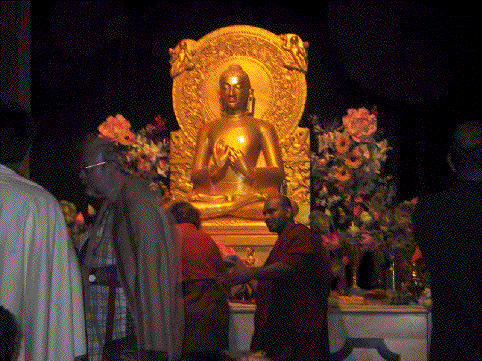
Inside the Buddhist Temple, where a puja was performed.
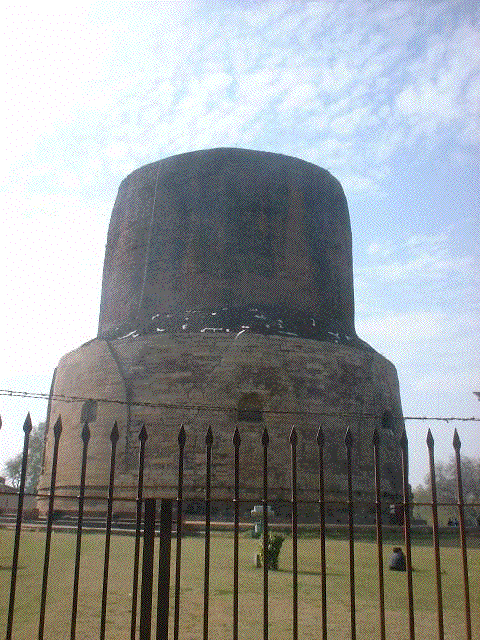
Dhamek Stupa, marking the place where Buddha preached his second sermon.
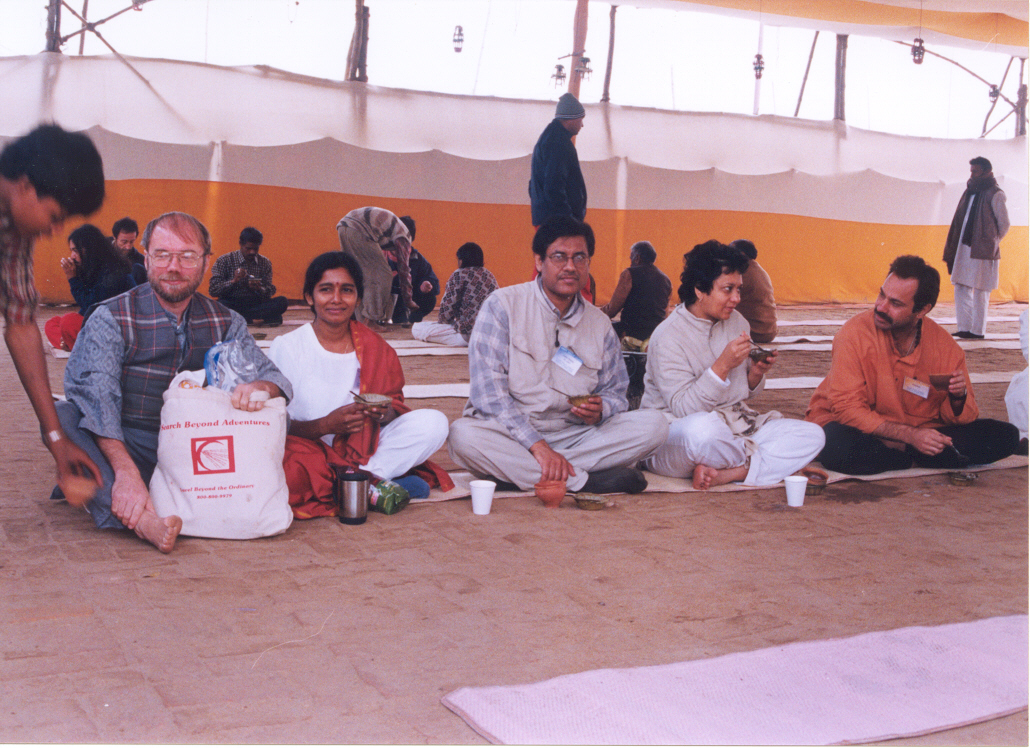
Our wonderful tour coordinators from Search Beyond Adventures; Kailash and Indra Dakshinamurthy. Indra selflessly devoted almost a year towards the Kumbha Mela and making sure that all plans came to fruition. Swamiji and the pilgrims would like to thank Indra and Kailash with all their hearts for their loving devotion towards the project. In the picture, Kailash and Indra are seated for one of our delicious lunches together with other volunteers.
By Wolfgang Bischoff
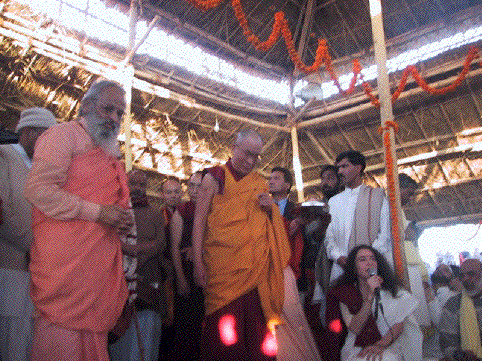
Swami Veda Bharati, His Holiness the Dalai Lama and Pandit Dabral.
Shri Swami Veda Bharati rose like a shining star into the sky of love, selfless service, joy and devotion of the Maha Kumbha Mela 2001. I was able to share with my beloved elder brother and dear spiritual teacher a lot of painful processes since the Maha-Samadhi of our Gurudev Shri Swami Rama.
I had criticized him for some of his worldly actions, but never his spiritual achievements and depths. I for myself was struggling to understand the initiation poem of Goethe &endash; "The Secrets" where he says; "From the violence that binds all living beings, only that human being can free himself who conquers himself." But how to conquer oneself? Shri Swami Veda has been offering me teachings over the last four years. Blamed and humiliated by others so that I often wanted to hurt them, he never said an unfriendly or negative word. Often, I felt he was sad; but always he tried to understand and even lovingly supported his brothers and sisters, disciples and students.
The culmination of that conquest I experienced in the Maha Kumbha Mela. Swamiji's heart was overflowing with love, and from the heart of Swami Chidananda Saraswati (Muniji) issued so much love and devotion for him that I often felt tears in my eyes. When finally through the grace of the Himalayan Tradition, Swamiji was standing between the Shankaracharya and the Dalai Lama, and Muniji celebrated with all of us the Saumya Mantra, my heart felt a fullness like never before, because my longing was fulfilled to work together in a stream of mankind. It is an ever-flowing stream which does not distinguish between religions, cultures and differences, but which is living for the teaching of self-conquest as a necessary condition of peace for all human beings, sharing and respecting their own values and rituals, their honesty and authenticity.
Shri Swami Veda, the Shankaracharya, and the wonderfully humble and so powerful Dalai Lama invoked the presence of our Guruji and created a family of worldwide conquerors of their own little egos, guided by the love of the heart, by the deepest compassion, and by the voice of their conscience. The day after this joint ceremony, Swamiji invited the presence of the spirit of our Guruji through the recitation of the "Akanda Mandala Mantra" and gave wonderful initiations to eight brothers and sisters. The presence of our Guruji showed to me the conquest and the acceptance of Shri Swami Veda, and I remembered Swami Rama saying to me in 1994 at the Ashram in Rishikesh: "A man like Swami Veda, of his quality and wisdom, such an accomplished meditator you can search for in all India."
The experience of pure love and devotion, and the deepest respect for every living being vibrating from Shri Swamiji's heart all these days, and the deepest love and respect he received openly in public from the Shankaracharya, the wonderful Dalai Lama and Muniji, is evidence enough for me that the Himalayan Tradition has a worthy successor, whom I have had the pleasure and grace to serve for the last 20 years, and whom I will serve to the end of his life. Shri Swami Rama had always said that our path is the path of self-conquest; and Swami Veda has shown that he is presenting that path through his own conquest.
Seeing and experiencing the deep love Muniji showed Shri Swami Veda, my beloved brother Ingo from Berlin and I felt an experience of ourselves bathed in love, devotion and selfless service. On two occasions came the vision of our Guruji upon us, honoring us with grace and blessings. In deepest gratitude and reverence, and with all the love in my heart, I bow before my beloved elder brother and spiritual guide.
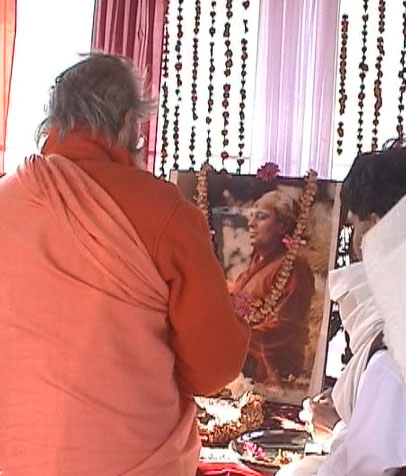
Swami Veda Bharati honoring H.H. Swami Rama of the Himalayas after the Mauna Amavasya.
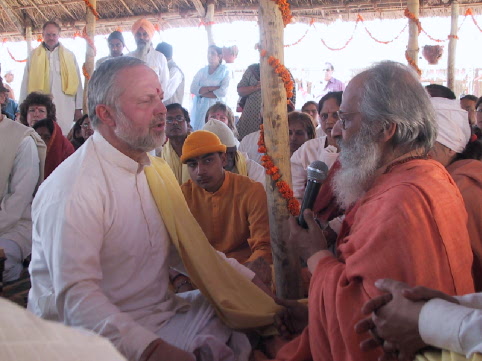
Wolfgang Bischoff receives an initiation from Swami Veda.
Wolfgang Bischoff
Hamburg, Germany
February 2001
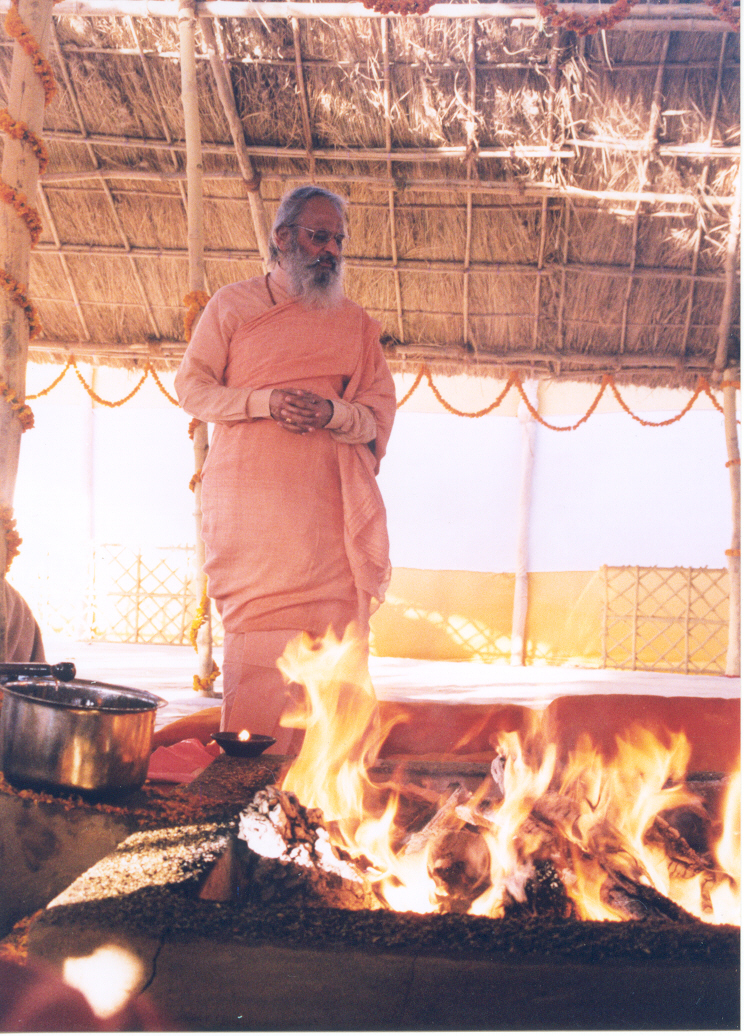
Maha Mandaleshwara Sri Swami Veda.
Keep informed - join our two newsletters:
Copyright 2001 West-Art
PROMETHEUS, Internet Bulletin for Art, Politics and Science.